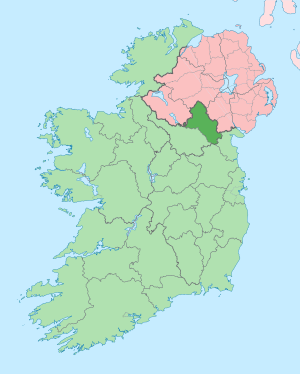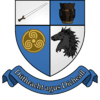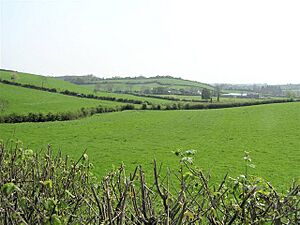County Monaghan facts for kids
Quick facts for kids
County Monaghan
Contae Mhuineacháin
|
||
|---|---|---|
|
||
| Nickname(s):
The Drumlin County The Farney County
|
||
| Motto(s): | ||
 |
||
| Country | Ireland | |
| Province | Ulster | |
| Region | Northern and Western | |
| Established | 1585 | |
| County town | Monaghan | |
| Area | ||
| • Total | 1,295 km2 (500 sq mi) | |
| Area rank | 28th | |
| Highest elevation
(Slieve Beagh)
|
373 m (1,224 ft) | |
| Population
(2022)
|
||
| • Total | 65,288 | |
| • Rank | 28th | |
| • Density | 50.415/km2 (130.58/sq mi) | |
| Time zone | UTC±0 (WET) | |
| • Summer (DST) | UTC+1 (IST) | |
| Eircode routing keys |
A75, A81, H18, H23
|
|
| Telephone area codes | in the South of the County 042 - Carrickmacross and Castleblayney in the North of the County 047 - Clones and Monaghan | |
| Vehicle index mark code |
MN | |
County Monaghan (pronounced MON-ə-hən; Irish: Contae Mhuineacháin) is a county in Ireland. It is located in the province of Ulster. The county is part of the Northern and Western Region. It is named after the town of Monaghan.
The Monaghan County Council is in charge of local government for the area. In 2022, about 65,288 people lived in County Monaghan. The county was created in 1585. This happened when the local rulers of Airgíalla agreed to join the Kingdom of Ireland. After the Irish War of Independence in the 1900s, Monaghan became part of the Irish Free State. This was instead of joining Northern Ireland.
Contents
Exploring County Monaghan
County Monaghan is one of Ireland's smaller counties. It is the fifth smallest in terms of land area in the Republic of Ireland. It is also the fourth smallest by population. Among the nine counties of Ulster, it has the smallest population.
Areas of Monaghan
County Monaghan is divided into five main areas called baronies:
- Cremorne (Irish: Críoch Mhúrn)
- Dartree (Irish: Dartraighe)
- Farney (Irish: Fearnaigh)
- Monaghan (Irish: Muineachán)
- Truagh (Irish: An Triúcha)
Towns and Villages
Here are some of the towns and villages you can find in County Monaghan:
- Ballinode
- Ballybay
- Carrickmacross
- Castleblayney
- Clones
- Clontibret
- Doohamlet
- Drum
- Emyvale
- Inniskeen
- Glaslough
- Killanny
- Knockatallon
- Magheracloone
- Monaghan
- Newbliss
- Oram
- Rockcorry
- Scotshouse
- Scotstown
- Smithborough
- Threemilehouse
- Tydavnet
- Tyholland
- Truagh
Biggest Towns in County Monaghan (2016 Census)
- Monaghan = 7,678 people
- Carrickmacross = 5,032 people
- Castleblayney = 3,607 people
- Clones = 1,680 people
- Ballybay = 1,241 people
Nature and Landscapes
Some important mountains in Monaghan include Slieve Beagh, Mullyash Mountain, and Coolberrin Hill. The county also has many lakes. These include Lough Avaghon, Dromore Lough, and Muckno Lough.
Several rivers flow through Monaghan. The River Fane runs along the border with County Louth. The Ulster Blackwater is found near the Tyrone border. The Dromore River links Cootehill to Ballybay.
Monaghan has forests like Rossmore Forest and Dartrey Forest. Most of the trees in these forests are conifers. There are only small areas of native woodland left. This is because of a long history of farming and forestry. The Finn Bridge is a crossing point over the River Finn. It connects Monaghan to County Fermanagh.
Geology and Resources
Lead was once mined in County Monaghan. Some old mines include Annaglogh Lead Mines and Lisdrumgormley Lead Mines.
A Look at History
In 1585, an English leader named Sir John Perrot visited the area. He met with the local Irish chiefs. They asked for Ulster to be divided into counties. This led to the creation of County Monaghan. The county was split into five baronies. These were Farney, Cremorne, Dartrey, Monaghan, and Truagh.
After a rebellion by Hugh O'Neill, Earl of Tyrone was defeated in 1603, Monaghan was different from other Ulster counties. Its lands were left with the native chiefs. In the Irish Rebellion of 1641, the local families joined a larger uprising. After their defeat, some Scottish and English families moved into the county.
Waterways and Transport
The old Ulster Canal runs through County Monaghan. Waterways Ireland is working to reopen part of this canal. It will connect Lough Erne to Clones.
Railways in Monaghan
A railway line connected Monaghan town to Belfast in 1858. It later connected to Clones in 1863. This railway became part of the Great Northern Railway. After Ireland was divided in 1922, the border caused train delays. In 1957, the Northern Ireland government closed parts of the line. This meant passenger services stopped in Monaghan. By 1960, all railway services in Monaghan had ended.
Culture and Buildings
County Monaghan is famous as the birthplace of Patrick Kavanagh. He was a very important Irish poet in the 20th century. Many of his poems, like "Stony Grey Soil," are about the county.
Many talented artists have come from Monaghan. George Collie (1904–1975) was a painter born in Carrickmacross. His works are in important galleries like the National Gallery of Ireland.
The writer Sir Shane Leslie (1885–1971) also lived in County Monaghan. He lived at Castle Leslie in Glaslough. He was a cousin of Sir Winston Churchill. Leslie was a friend to many famous writers and politicians. The American novelist F. Scott Fitzgerald even dedicated a book to him.
The Monaghan County Museum is a top museum in Ireland. It is located in Monaghan Town. The museum shows the rich history of County Monaghan and its people.
The county has many beautiful buildings. Most of these were built in the Georgian and Victorian times. Examples include Church Square in Monaghan Town and grand country houses like Castle Leslie. Important churches include St Joseph's Catholic Church in Carrickmacross. Also, St Macartan's Catholic Cathedral in Monaghan Town is a notable building.
Economy and Jobs
Farming is a very important part of County Monaghan's economy. About 12% of the people in the county worked in farming in 2011. This is much higher than the national average. Monaghan is also the main place for egg supplies in the Republic of Ireland.
Famous People from Monaghan
Writers and Thinkers
- Patrick Kavanagh (1904–1967) – A famous poet.
- Patrick McCabe – A novelist.
- Eugene McCabe – A playwright and novelist.
- Sir Shane Leslie (1885–1971) – A writer and political activist.
- John Robert Gregg (1867–1948) – He created a modern way of writing shorthand.
- Sir Tyrone Guthrie (1900–1971) – A writer and theater director.
Sports Stars
- Barry McGuigan – A world boxing champion, born in Clones.
- Tommy Bowe – A professional Rugby Union player.
- James Cecil Parke (1881–1946) – A talented tennis and rugby player. He won an Olympic silver medal in tennis.
- Kevin McBride – An Olympic Boxer.
- Daniel McKenna – A rally car driver.
- John McKenna (1855–1936) – The first manager of Liverpool Football Club.
Music and Entertainment
- Oliver Callan – A satirist and mimic.
- Terry Cavanagh – A video game designer.
- The Flaws – An indie rock band from Carrickmacross.
- "Big Tom" McBride (1936–2018) – A popular country singer.
- Ryan Sheridan – A singer and guitarist.
Actors
- Caitriona Balfe – A fashion model and actress.
- Ardal O'Hanlon – An actor and comedian.
- Charlene McKenna – An actress.
- Aoibhinn McGinnity – An actress.
Artists
- Alexander Williams (1846–1930) – An artist.
Religious Figures
- George Jeffreys (1889–1962) – He founded the Elim Pentecostal Church in Monaghan in 1915.
Sister Cities
County Monaghan has special connections with these places around the world:
 Geel, Flanders, Belgium
Geel, Flanders, Belgium Emyvale, Prince Edward Island, Canada
Emyvale, Prince Edward Island, Canada Miramichi, New Brunswick, Canada
Miramichi, New Brunswick, Canada Peterborough, Ontario, Canada
Peterborough, Ontario, Canada
Images for kids





